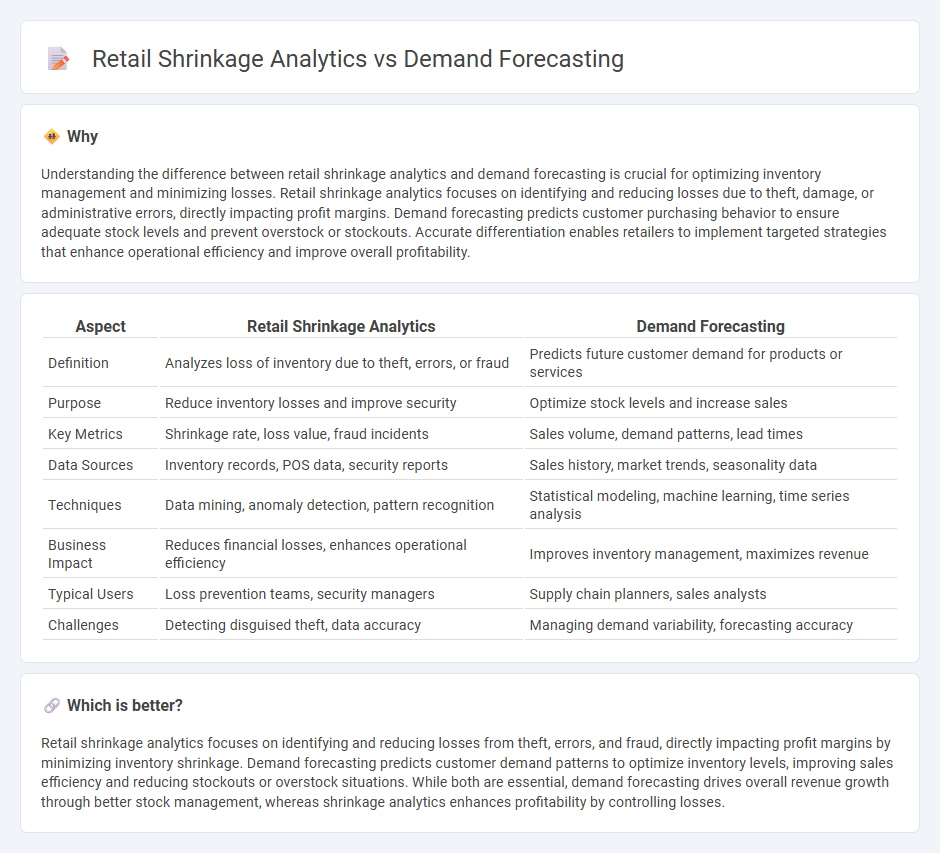
Retail shrinkage analytics focuses on identifying and reducing losses caused by theft, errors, and fraud, using data-driven insights to improve inventory accuracy and profitability. Demand forecasting leverages historical sales data and market trends to predict future customer demand, optimizing stock levels and supply chain efficiency. Explore the impact of retail shrinkage analytics and demand forecasting on operational success and revenue growth.
Why it is important
Understanding the difference between retail shrinkage analytics and demand forecasting is crucial for optimizing inventory management and minimizing losses. Retail shrinkage analytics focuses on identifying and reducing losses due to theft, damage, or administrative errors, directly impacting profit margins. Demand forecasting predicts customer purchasing behavior to ensure adequate stock levels and prevent overstock or stockouts. Accurate differentiation enables retailers to implement targeted strategies that enhance operational efficiency and improve overall profitability.
Comparison Table
| Aspect | Retail Shrinkage Analytics | Demand Forecasting |
|---|---|---|
| Definition | Analyzes loss of inventory due to theft, errors, or fraud | Predicts future customer demand for products or services |
| Purpose | Reduce inventory losses and improve security | Optimize stock levels and increase sales |
| Key Metrics | Shrinkage rate, loss value, fraud incidents | Sales volume, demand patterns, lead times |
| Data Sources | Inventory records, POS data, security reports | Sales history, market trends, seasonality data |
| Techniques | Data mining, anomaly detection, pattern recognition | Statistical modeling, machine learning, time series analysis |
| Business Impact | Reduces financial losses, enhances operational efficiency | Improves inventory management, maximizes revenue |
| Typical Users | Loss prevention teams, security managers | Supply chain planners, sales analysts |
| Challenges | Detecting disguised theft, data accuracy | Managing demand variability, forecasting accuracy |
Which is better?
Retail shrinkage analytics focuses on identifying and reducing losses from theft, errors, and fraud, directly impacting profit margins by minimizing inventory shrinkage. Demand forecasting predicts customer demand patterns to optimize inventory levels, improving sales efficiency and reducing stockouts or overstock situations. While both are essential, demand forecasting drives overall revenue growth through better stock management, whereas shrinkage analytics enhances profitability by controlling losses.
Connection
Retail shrinkage analytics identifies patterns of loss caused by theft, errors, or fraud, enabling targeted interventions to reduce shrinkage. Demand forecasting predicts customer purchasing behavior and inventory needs, improving stock management and minimizing excess or obsolete inventory. Integrating shrinkage analytics with demand forecasting enhances overall inventory accuracy, optimizes supply chain efficiency, and increases profitability by aligning stock levels with actual consumer demand while mitigating losses.
Key Terms
**Demand Forecasting:**
Demand forecasting leverages historical sales data, market trends, and statistical models to predict future consumer demand, enabling retailers to optimize inventory levels and reduce stockouts or overstock situations. Accurate demand forecasting enhances supply chain efficiency, improves customer satisfaction, and drives revenue growth by aligning product availability with consumer purchasing patterns. Explore more about how advanced demand forecasting techniques can transform retail operations and profitability.
Sales Prediction
Demand forecasting utilizes historical sales data, market trends, and seasonal patterns to predict future product demand, optimizing inventory levels and reducing stockouts. Retail shrinkage analytics focuses on identifying and mitigating losses caused by theft, errors, or fraud, ensuring accurate sales data for improved financial performance. Explore how integrating demand forecasting with shrinkage analysis can enhance overall sales prediction accuracy and retail profitability.
Inventory Planning
Demand forecasting uses historical sales data, market trends, and seasonality to predict future product demand, enabling retailers to optimize inventory levels and reduce stockouts or overstock situations. Retail shrinkage analytics identifies losses due to theft, errors, or fraud, helping inventory planners minimize discrepancies and improve stock accuracy. Explore how integrating both approaches enhances inventory planning efficiency and profitability.
Source and External Links
Types of Demand Forecast - Demand forecasting uses predictive analysis of past data to anticipate future customer demand, helping companies optimize inventory and operational decisions with various methods like active forecasting, econometrics, and market research.
Demand Forecasting: A Complete Guide - Demand forecasting predicts future market demands enabling businesses to optimize supply chains, reduce costs, and improve decision-making by anticipating market trends and consumer behavior.
Demand forecasting: types, methods, and examples - Common demand forecasting methods include trend projection using past sales data, market research via customer surveys, and sales force composite forecasts based on sales team insights.
 dowidth.com
dowidth.com